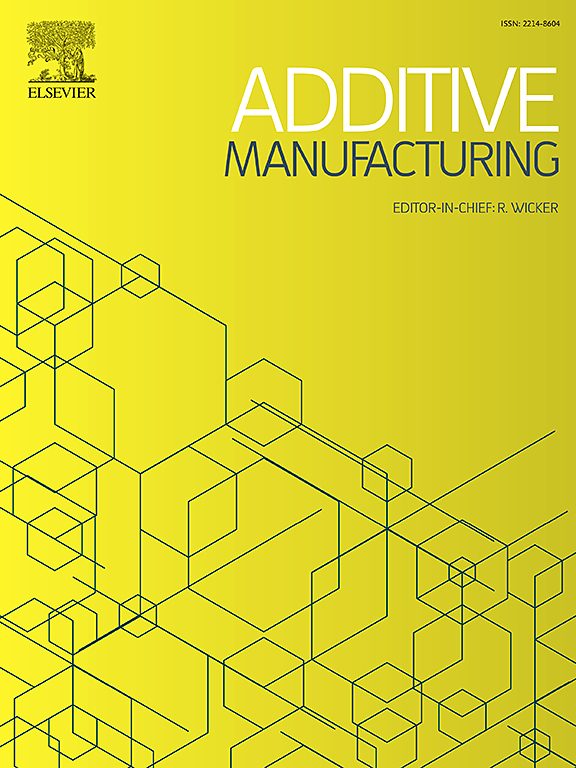Unveiling the influence of printing surfaces in powder bed fusion electron beam melting through multiphysics simulation
IF 10.3
1区 工程技术
Q1 ENGINEERING, MANUFACTURING
引用次数: 0
Abstract
Controlling internal defects within as-built parts is one of the great interests in the additive manufacturing field. In this study, we explore the powder spreading and defect evolution mechanisms on realistic printing surfaces through a comprehensive multiphysics simulation. The efficacy of a flat surface criterion for internal defect elimination was verified using a machine learning approach. The steady layer thickness in the electron beam melting process was estimated for different printing surfaces using the simulated powder bed density obtained through a high-fidelity discrete element method model. The steady layer thickness was greater on the flat printing surface compared to the rough surface due to high consolidation shrinkage. Monte-Carlo simulation revealed that electron backscattering is more pronounced on peaks of a rough surface than on a powder bed, due to the limited reabsorption of reflected electrons. The influence of the printing surface on melt pool stability and internal defect evolution was investigated using thermo-fluid dynamic simulations. Under identical process conditions, the molten pool surface exhibited greater stability on a rough printing surface than on a flat one, due to enhanced fluid flow. The flat printing surface resulted in lack of fusion defects < 100 μm in the external side region due to suppressed heat accumulation and a large steady layer thickness. Periodic deep valleys on rough surface can cause coarse defects < 200 μm in the external side region, as the melt pool depth is insufficient to match the increased local layer thickness in the valleys. Therefore, it was demonstrated that the printing surface must be considered to optimize outermost defects in as-built parts produced by the powder bed fusion electron beam melting process.
控制成型零件的内部缺陷是增材制造领域的一大热点。在本研究中,我们通过全面的多物理场仿真探索了现实打印表面的粉末扩散和缺陷演变机制。利用机器学习方法验证了消除内部缺陷的平面标准的有效性。利用通过高保真离散元素法模型获得的模拟粉末床密度,估算了不同印刷表面在电子束熔化过程中的稳定层厚度。由于固结收缩率较高,平面印刷表面的稳定层厚度要大于粗糙表面。蒙特卡洛模拟显示,由于反射电子的再吸收有限,粗糙表面峰值上的电子反向散射比粉末床更明显。热流体动力学模拟研究了印刷表面对熔池稳定性和内部缺陷演变的影响。在相同的工艺条件下,由于流体流动增强,粗糙印刷表面比平坦印刷表面的熔池表面表现出更高的稳定性。由于热量积聚受到抑制,稳定层厚度较大,平整的印刷表面在外侧区域没有 100 μm 的熔融缺陷。粗糙表面上的周期性深谷会导致外侧区域出现粗缺陷 < 200 μm,因为熔池深度不足以匹配深谷中增加的局部层厚度。因此,在优化粉末床熔融电子束熔化工艺生产的坯件最外层缺陷时,必须考虑印刷表面。
本文章由计算机程序翻译,如有差异,请以英文原文为准。
求助全文
约1分钟内获得全文
求助全文
来源期刊

Additive manufacturing
Materials Science-General Materials Science
CiteScore
19.80
自引率
12.70%
发文量
648
审稿时长
35 days
期刊介绍:
Additive Manufacturing stands as a peer-reviewed journal dedicated to delivering high-quality research papers and reviews in the field of additive manufacturing, serving both academia and industry leaders. The journal's objective is to recognize the innovative essence of additive manufacturing and its diverse applications, providing a comprehensive overview of current developments and future prospects.
The transformative potential of additive manufacturing technologies in product design and manufacturing is poised to disrupt traditional approaches. In response to this paradigm shift, a distinctive and comprehensive publication outlet was essential. Additive Manufacturing fulfills this need, offering a platform for engineers, materials scientists, and practitioners across academia and various industries to document and share innovations in these evolving technologies.
 求助内容:
求助内容: 应助结果提醒方式:
应助结果提醒方式:


